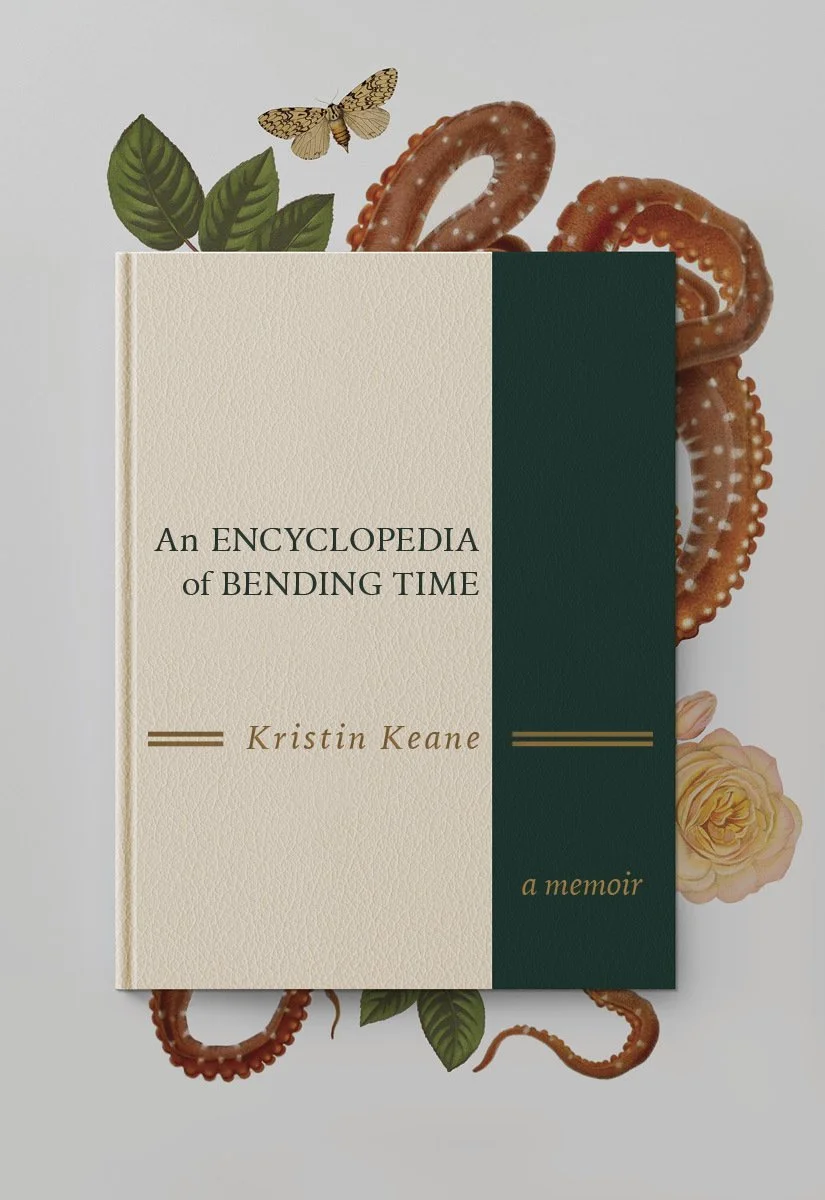An Encyclopedia of Bending Time
Barrelhouse Books | April, 2022 | $18.00
Reviewed by Whitney (Walters) Jacobson
I’ve been waiting for Kristin Keane’s An Encyclopedia of Bending Time for years, though I didn’t know it until this past February when I chanced upon a social media post promoting the book’s forthcoming publication and gorgeous cover.
Keane’s book is a hermit crab memoir, adopting the form of an encyclopedia. I relish presenting hermit crab essays to students: watching them attempt to bend their minds around what an essay can be; fail, given the vastness of the genre; and then run with the possibilities. So, chancing upon a hermit crab memoir, which can push the limits of possibility further, even as it restrains with a strict form, lands me with the exact oxymoron of a book I want to read. Add to the mix this one is a grief memoir, and well, my Saturday is booked.
In An Encyclopedia of Bending Time, Keane ruminates on the anticipated, but resisted, loss of her mother’s presence and how grief warps time after the loved one’s death. Though Keane never mentions The Year of Magical Thinking (Knopf, 2005), Keane appears to live through her own year of magical thinking, wherein she tries to locate a loophole to change the past and make meaning from objects, occurrences, and theories in the wake of her mother’s death. In a Didion-esque direct manner, Keane asserts: “This is not an attempt to get over something I never will, but to understand it. I am trying to find a way for you and I to not part, and also navigate a certain type of parting” (110, her italics).
Prior to reading Keane’s memoir, I referred students to Rebecca Brown’s Excerpts from a Family Medical Dictionary (U of Wisconsin Press, 2003), another hermit crab memoir, though looser in form: a dictionary entry stands alone on a page before its corresponding chapter. Rather than alphabetizing the terms, Brown organizes them chronologically.
I was pleased to see Keane’s stricter encyclopedia structure, with alphabetized entries, no chapters to speak of, and cross-references (e.g. from the CHILDHOOD entry: “See also ALTARS; TAROT” [24]). I found this format to read as accurate representation of grief: a mosaic of impressions, desires, and touchstones, endlessly rearranged in hopes of new insights and more time with the deceased.
From ALPHABET: “It is important to arrange these words now, to write us into something . . . . I’m trying to say I am attempting to contain myself—to contain you” (5).
From BLUR: “Time smears my memories like fingers in dabs of wet paint. Sometimes I am not so certain anymore about the accuracy of my recall. A mimesis—is that what this is? How do you stop a memory from becoming fictionalized, or preserve something not written down?” (17).
From ENCYCLOPEDIAS: “Encyclopedias provide factual information, but they, like all texts, are authored, constructed so that subjects become captured. Things can be held under a magnifying glass one entry at a time, forever. Does that permanence give them a sort of truth that they are still existing?” (33).
From GONE: “Why can I remember the sheen of the food drippings on my fingertips, but I can’t remember what you said while we sat together?
Time has already shifted me. If all I’m doing is fooling myself by saying I have memories I don’t really have, then what really is there left of you?” (53).
I read Keane’s memoir straight through, and despite the anachronistic entries, it is cohesive. Keane is aware of what her sequential readers will comprehend as she presents fresh information, revisits old ideas, and makes new meaning from her loss. That said, I’m intrigued by the option of following each cross-reference like a “choose your own adventure” book and what insights that experience would reveal.
One feature facilitating unity is Keane’s use of second person to address her mother, as well as Keane’s imagined responses from her mother. The sense of communion brings readers into Keane’s loss.
What if it’s you watching me writing about you screaming? Watching me writing about Interstellar?
‘Oh Kristin, that’s so dark!’ you would say. ‘What if the other side is a side that another part of you is here with me now, that you just don’t know or feel yet? What if we are together right now and just don’t understand it?’
You see what I’m doing—don’t you? I am trying to give you a voice that you no longer have. (94, her italics)
By the time Keane’s analysis reaches the letter Z, she seems to have crafted her own satisfying theory about death: “[Stephen Hawking] postulated that the universe started from a point of zero, comprising the past, present and future all at once. It’s a math I can’t explain or understand, but the idea, I think, is beautiful . . . Maybe we end at the center of a black hole, us and everything else crushed by an infinite force. Maybe the force is gravity. Maybe it is our love” (119-120).
That’s a theory of bending time I will gladly give credence to.
Whitney (Walters) Jacobson holds an MFA in Creative Writing from Minnesota State University Moorhead. Her poetry and creative nonfiction have been published in Punctuate, Feminine Collective, Up North Lit, After the Pause, and In the Words of Womyn International, among other publications. She is currently working on a collection of essays exploring skills, objects, and traits passed on (or not) from generation to generation. She maintains a curiosity in memoir and the themes of feminism, water, inheritance, blue-collar work, and grief.

